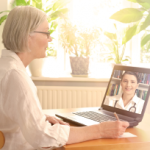 Telemedicine has yet to gain a foothold in rheumatology practice. A quick Google search shows but a handful of articles, most with headlines, such as, “Does Telemedicine Work in ‘Hands-on’ Specialties?” or “Seven Reasons to Embrace Telemedicine.” And the legal barriers, such as licensure, consent, patient encounter, scope of services, reimbursement and patient privacy, can be challenging to overcome.
Telemedicine has yet to gain a foothold in rheumatology practice. A quick Google search shows but a handful of articles, most with headlines, such as, “Does Telemedicine Work in ‘Hands-on’ Specialties?” or “Seven Reasons to Embrace Telemedicine.” And the legal barriers, such as licensure, consent, patient encounter, scope of services, reimbursement and patient privacy, can be challenging to overcome.
Yet practitioners utilizing telemedicine—also known as telehealth—for their rheumatology patients really love it. It solves many of the access issues rheumatology patients encounter and can increase provider productivity, according to Daniel Albert, MD, professor of medicine and pediatric rheumatologist at the Center for Telehealth at Dartmouth-Hitchcock Medical Center in Lebanon, N.H.
Benefits
“There are a lot of patients we see that cannot get to us at all,” says Dr. Albert, who adds that access is not just a rural issue. “Telemedicine is far, far better than the care those patients are getting, which is no care at all.
“The other motivating factor is money. It saves time and money, for the patient and for the providers. There are a lot of applications for telemedicine. If you can overcome the administrative barriers, it can be widely used.”
Personal Experience
Dr. Albert has incorporated telemedicine into his practice for roughly the past four years. He has a video camera attached to the laptop he carries with him during the day. The software the Dartmouth-Hitchcock Medical Center uses provides a Health Insurance Portability and Accountability Act (HIPAA)-compliant video link to patients. Both the video camera and the software are relatively inexpensive, he says. During clinic, he toggles between live patient encounters and video appointments.
“It is really flexible. A [telehealth] encounter is roughly one-third as long as a conventional, face-to-face appointment,” he says. “It doesn’t require a lot of office space, either. I have seen no reduction in RVUs. For me, a telemedicine visit is actually better for my schedule. I can do four telemedicine returns in an hour.”
Dr. Albert says administration and a provider’s comfort level with the technology and format are the main challenges. But he believes both can be solved with help from technology and billing support staff. His group just published some data on telemedicine practice in Seminars in Arthritis and Rheumatism, which he says validates telemedicine in a variety of settings.
Motivated providers will find most rheumatology patients are comfortable with the video chat format, too.
“Don’t assume older patients won’t like telemedicine,” Dr. Albert continues. “It is actually the opposite. Older patients are early adopters. They are used to Skypeing with their grandchildren. Many are pretty savvy; most are very comfortable.”
Consider How to Incorporate Telemedicine into Your Practice
Dr. Albert suggests rheumatologists think about the different types of encounters that would work best in a video chat setting. Although performing a physical exam is important in some patients, he says it is not required for all visits. And those patients might just be perfect candidates for telemedicine.
“Yes, the main downside is that you can’t examine the patient, physically. That is a little hard for rheumatologists to get used to,” he explains, noting well-trained nurses or “presenters” on the other end of the video connection make a difference, both in efficiency and patient satisfaction. For example, some training is needed to assist rheumatologists with physical exam maneuvers or adjusting the camera to look into the patients’ mouth.
“[Consider] follow-ups of patients with stable disease,” he says. “Many times, the majority of what you are doing is talking to the patient—and telemedicine is much better than a phone call, especially with the non-verbal communication.”
Looking to the future, Dr. Albert also imagines a nice intersection in rheumatology: advancements in fitness technology and telemedicine.
“I honestly think that in 10 years, telemedicine will be incorporated in every practice,” he says, noting he envisions a time in the not-too-distant future when payers will latch on to the benefits of telemedicine.
For now, however, he hopes all rheumatologists will take some time to get to know telemedicine a little better.
“Envision a way in which telemedicine would make your practice and your patients’ care improved,” he says. “I don’t think it is for every patient or every practice, but I think there is a substantial number of patients and practices where it could be integrated in a very productive way.”
Richard Quinn is a freelance writer in New Jersey.
Learn More
Review the WHO’s National eHealth Strategy Toolkit.
Learn about the legal challenges.
Read about the ethical challenges.



